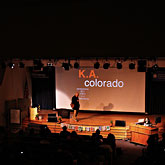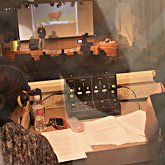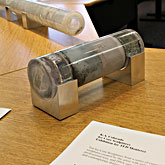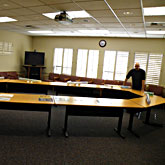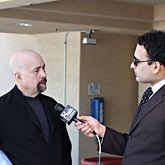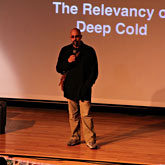The Cow On The Iceberg: The Relevancy of Deep Cold - Communicating Climate Concerns Through Art
By K.A. Colorado, Environmental Artist
TEDx Monterey Conference
April 15, 2010
I would like to talk about a unique and unusual event that happened to me five years ago on one of my trips to the Antarctic ice fields. While at sea, during an approach to ice fields from the Perito Morino Glacier, I spotted several icebergs along the horizon. The bergs were surreal in their brilliance of turquoise against dark sky and ocean, and at first I thought I was looking at bits of paper floating. Upon the approach to this brilliant optical presentation, I spotted a black dot moving across the surface.
This illusion seemed to be otherworldly, and brought to mind visions of ghosts or monsters or phantoms. I kept straining to realize what I was looking at. Coming closer, I realized that it was a four-legged creature, but because of its environmental context, I still wasn't able to understand what I was looking at. It took me a while, but I finally understood that I was looking at a cow or some kind of a bull standing on the iceberg in the middle of the ocean. This seemed horrific and a bit scary, but the iceberg kept traveling on, with its passenger perched on top, along with succeeding bergs that followed it, and I gradually lost sight of it.
Upon returning to the point of debarkation, I asked locals about this phenomenon I had just witnessed. I was greeted with laughs as they mentioned how cows released from the early monks' monasteries became wild and learned to utilize the iceberg as a vehicle to get from one foraging area to the next. Historically, it seemed, that over the past two hundred years, wild cows have used these local bergs to travel on and off shore for foraging. I realized then that it would be a great visual to paint.
The cow on the iceberg remains in my memory as a fantastic and otherworldly visual for a moment. The cow on the iceberg also is an introduction to our relevancy of deep cold.
The possibility of an animal unleashed and abandoned returning to its wildness while perched on an eternal and special natural sculpture of the iceberg can also be a connotation for the symbiotic relationship of Polar material to our existence and activity.
In making observations, the interesting thing about the cow on the iceberg, is that the relationship can be viewed from different points of view. The relationship of the iceberg to a warm mammal emitting methane on the same plane in the middle of an ocean can be viewed also as a mirror of man's activities beginning in the industrial age that have resulted in the increase of carbon and methane release.
The relevancy of deep cold to our existence, while not felt overtly by everyone at all times, is still a necessary component to our way of thinking and operating. One of the tragedies of a climate-impacted world would be a lack of this deep cold resource physically, psychologically, and spiritually. In all probability, a moist, warm world may not be the end of life; however, it would be much less without the contrasts of the Polar climate regions. The dramatic season changes, crisp cool nights, and warm days, as well as vegetation norms and animal cycles, become less defined in a world without deep cold.
The cow on the iceberg is also a comparative device for the relevancy of cold.
The importance of deep cold to human existence is often overlooked. The direction we usually gravitate toward is heat. Heat creates activities. Heat creates ease of methods. Heat creates intellectual and physical warmth, which we as a species naturally gravitate toward. However, the importance of deep cold cannot be underestimated. I believe deep cold has always been the other point of the compass, directing us to build habitat and shelter, to create food storage, and requiring communication.
I think in early man's history, the reality of the Polar regions affected life and habitat throughout the world, and the proximity to these extremes created unique survival components by the people who had to be in this proximity. These are the physical realities of deep cold.
In addressing the physical impact of deep cold, we need to realize that one of the most important relationships to ocean circulation is Polar ice. Without the massive amounts of frigid Polar water triggering the transportation mechanism for ocean currents – or what we term "the ocean conveyor belt" – the probabilities for serious deficiencies of oxygen in our atmosphere would result. The question of the health of the oceans is directly connected to the health of the Polar regions.
North Arctic ice melts into the ocean currents, which are vital for the ocean circulation including along the Pacific Coast specific to the Monterey area. The ocean currents require deep cold from Arctic areas for the conveyor belt to function. This conveyor belt is the essence of life in the ocean and helps provide the oxygen content for the world.
Psychologically, the concept of absolute cold and absolute absence of competing visual elements is the closest approximation we have to leaving this planet and going into space. And while the experience of space is not yet a reality for most people to access, the Polar regions can mimic some conditions of deep space better than any other place on our planet.
This psychology of man alone, reflecting his singular purpose, is highlighted in the Polar regions. The psychological impact: The supreme quiet of the Polar regions, with the absolute predominating blankness of landscape detail, is the stage to measure our unique personality and question our existence. These considerations form the backdrop for our needs for the spiritual rationale.
The spiritual impact of deep cold is also another characteristic in our behavior that is seminal to our conduct, intellectual considerations, and self-awareness. After some time spent in Polar landscapes, the spiritual component becomes apparent even to an agnostic visitor.
The Polar effect of visibility and void in practical and intellectual considerations requires the individual isolated in deep cold to come to grips with the overwhelmingly extreme vastness. This vastness is measured by one's diminutive stature and minimal voice in the deep cold ice field. Attempting to rationalize one's insignificance and sense of aloneness, is akin to grasping the reality and purpose of death in the battlefield. The Polar extreme of deep cold requires a personal definition – the spiritual realm realized. The sense of one with the force.
Another point of view considering the cow on the iceberg is that the animal perched on this natural platform, searching for food and life-sustaining resources, is also an animal emitting methane gases and driven to consume even more. This becomes a metaphor for humans standing on the natural world, consuming food, shelter, and resources that contribute to carbon emission. However, unlike the animal, we humans also consume materials that are not necessary but are embellishments. Because of our egos, we surround ourselves with toys, games, entertainment, and corporate rewards. These wants and desires, because of burgeoning population growth, become limiting and debilitating to simple survival and sustainability.
One of the fundamental questions that we must ask ourselves at this time is how can we manage sustainability for humans and animals, and address these climate concerns, through our social institutions. At this time, the question is whether or not our traditional American institutions of finance and politics can appropriately address the climate and Polar conditions. It is my belief that the arts and humanities should be an active component of this effort.
Popular political arenas and market corporate structures, while able to operate freely and in virtual and conceptual modes, require profit margins and philosophies that are in direct contradiction to mechanisms and policies that would enable us be able to protect the Arctic and Antarctic. This political correctness is not the easy avenue toward Arctic concerns and Polar climate issues. At this time of crisis in our country and international economic deterioration, we have become hamstrung and made ineffective by credit ratings, portfolio profits, and debt. Even employment and its insidious fears of unemployment become hurdles when attempting to coalesce public determination on global climate issues.
The confusion and guilt of these issues also must be leveled at our personal decisions and ambitions. In a consumer-built society, we as individuals have also put our institutional and material needs ahead of social and cultural expressions that would enrich our experiences and support our intimate relationship to the natural world.
In examining this animal on the ice, the differences between viewing media and viewing art – that is, the difference of interaction between citizen viewer to media, and citizen participant to art – must also be questioned. In media, seeing is believing – the sale or the pitch to convince the viewer to consume. In art, seeing is feeling – the search for a meaning or a deeper human quality.
Over long exposure to constant television, internet, and cyberspace entertainment, the citizen viewer can become a passive voyeur. The need for a true enhanced cultural arts platform that is not market value-driven but rather anchored in the humanities is central to balancing the situation. A true enhanced cultural arts platform provides the citizen viewer with ways to interact physically and intellectually to the display.
Rather than being passive, dance, drama, theatre, performance, and music become a much more interactive personal activity, bringing body and mind and confrontation to the fore.
In the condition of someone attending or viewing or dancing or singing, the physical interaction provides an ability to confront these issues, whereas television, media, advertising, and cyberspace can become passive. They are more of a voyeuristic entertainment, with a public that has no physical experience. This makes approaches to dealing with issues like climate that much more difficult. Whereas socially coming together through the humanities and in shared activities relative to climate is much more deliberate and apparent.
However, portraying climate through art is challenging. It's very difficult and a singular personal experience as an artist dealing with ice and cold.
Whether it is carving for extended periods in the Himalayas or the Alps or the Polar regions, the ability to create art still must be achieved in the studio, with planning and execution. In the Polar regions, it is impossible realistically to carry tools and material on site. Therefore, the period of time it takes in traveling and documenting deep cold areas is a solitary experience. But it is a worthwhile experience.
My personal artistic mentor is the late 19th century American landscape painter Frederic Edwin Church.
Church took a year to plan and execute an Arctic voyage, to find an iceberg, then to come back to the studio and work on it for an extended period of time.
Argentine artist Andrea Juan performs in the Antarctic. This type of art requires resource and funding.
Col. Ron Smith, with whom I work on certain projects, writes poetry about his Antarctic experience.
Lynne Cox, a great American hero and friend of mine, is a long-distance swimmer who swam from Alaska to Russia in the freezing waters of the Bering Sea. I have painted her portrait as part of my series of paintings of Icebergs.
I am a sculptor and painter. My solutions to arts are vastly different than a performance artist, or photographer, or even a writer.
But still to personally digest information and content on deep cold regions is a time-consuming effort. In my case it has taken 25 years to amass enough personal experience in deep cold around the world in order to express these things in artistic presentation.
Like the artist, a scientist also spends years writing and developing to prepare his thesis. One of the attributes that professional artists and scientists have in common is this journey of questioning and examination of subject material.
My work with scientists includes imbedding their scientific findings and text into sculptural replicas of ice core samplings. My attempt is to capture current contemporary dialogue of scientists and Polar professionals.
I work with Dr. Jorge Rabassa of CADIC-CONICET in Ushuaia, Argentina, as well as Canadian and Russian Scientists. I have also imbedded the scientific writings of Dr. James Hansen of NASA into Ice Core sculptures. Through my art I hope to acknowledge and make available to future generations what we saw and observed of climate at this time.
My purpose as a contemporary climate artists at this moment in time is to bring these climate issues to the public through art.
I now call upon organized institutions in business, government, and finance to set aside a percentage of resources and assets, and establish dedicated departments that are centered around the humanities specifically, to portray climate concerns through the arts.
Art can be an integral device bringing real consciousness to corporate decisions. Just being "green" as a corporate phrase placates the situation and diminishes, contains, and prevents real progressive, whereas the arts enable the thinking process to be in tandem with the operational model and implementation.
As in carbon credits and deficits, as in profit and loss margins, as in left and right politics, I believe there should also be institutionalized a continuing artistic expression, contemporary and artist-spearheaded, that will have an equal and continuing operational capacity. The reliance on science as an asset for decision-making is critical, as should be the asset of the humanities to corporate decision-making.
I believe that establishing and enabling these types of forums and ongoing dialogue from an artistic point of view, with artists in various disciplines contributing their influence and presentations, would bring a more complete reality and effect everyone's connection with Polar and climate decision-making.
Through the arts and the humanities, this connection between artists and industry, can bridge over competing political viewpoints, financial considerations, and moral camps.
This is what I hope to accomplish.

